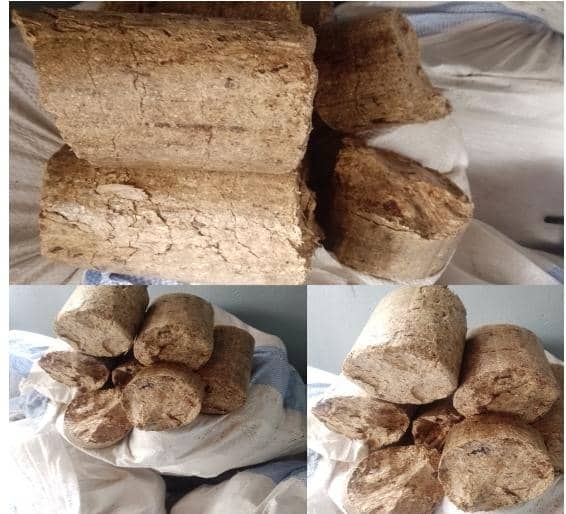By Samantha Mudadisi

1.0 Introduction
Briquettes are a type of fuel made from compressed organic matter, like sawdust or coconut shells. They are manufactured in a number of different locations throughout Manicaland, Zimbabwe. There are several larger-scale operations in the Chimanimani and Chipinge districts. The raw materials used to make briquettes are collected from all over the province, including from farms, sawmills, and even markets. The factories then compress the materials into briquettes, which are then sold to local vendors and businesses. They are a more sustainable alternative to traditional fuels like wood and coal, because they burn more efficiently and produce less smoke and ash but Deforestation has been the significant driver for the introduction of Briquettes because according to the constitution of Zimbabwe section 73(b), “every person has the right to have the environment protected for the benefit of present and future generations”.However the inception of Briquettes into the wider market of Mutare has been limited due to a number of barriers not to talk about their adoption by the community. This has seen them taking longer than expected to widely spread. This article serves to enlighten on challenges hindering the widespread of Briquettes, demography, rationale for their introduction and lastly the government response.
2.0 Situational analysis
In Manicaland sawdust constitutes 80% of waste. EMA is supporting such initiatives as they help in preserving the environment. This innovation was a step forward in reducing pollution and environment degradation initiated by deforestation. Although the uptake is still low as the operation only started, locals have begun to appreciate using briquettes as an alternative source of energy. Briquettes are being sold at $5 per 50kg; other small kilograms will be weighed on the scale to cater for those who cannot afford the 50kilograms one.
3.0 Rationale for the introduction of Briquettes
The introduction of Briquettes has been credited to the drive for curbing deforestation and the need to get rid of Sawdust as the main push factors. Deforestation is a major problem in Zimbabwe and deforestation rates have been estimated at between 0.1% and 0.7% per year. Deforestation in Mutare has also been a menace and it’s primarily caused by the demand for firewood and charcoal, which are used for cooking and heating. Another push factor for the introduction of Briquettes was the abounding quantities of sawdust which had become an eyesore at the Sawmills in Chipinge, Chimanimani and also in Mutare. Due to these causes it has led to the introduction of Briquettes as an alternative source of energy and livelihood.
4.0 Challenges hindering the widespread introduction
4.1 Lack of Knowledge
Many people are not aware of the environmental and health benefits of using briquettes, or of the negative impacts of using traditional fuels like firewood and charcoal.
4.2 Lack of access to briquette making equipment and training
.Many communities may not have the financial resources or expertise to acquire the necessary equipment and training. This can make it difficult for individuals and businesses to produce high-quality briquettes, which can limit their potential to gain acceptance and widespread use.
4.3 Lack of infrastructure for briquette production and distribution.
Most briquette making equipment is imported, and there is a lack of skilled workers who can operate and maintain the equipment. There are also few transportation networks in place to distribute briquettes to rural areas, where the need for alternative fuel sources is greatest. To add more there is limited access to financing for briquette- making businesses, which makes it difficult for entrepreneurs to get started.
4.4 Lack of fuel
In order for briquettes to be used effectively, they need to be burned in a stove that is designed to maximize their efficiency. However, many people in Mutare still use traditional stoves that are not suitable for briquettes.
5.0 Impacts of Briquettes on the environment
5.1 Positive Impacts
Briquettes have a number of environmental benefits compared to charcoal and firewood. Firstly, they produce less air pollution, which improves air quality and reduces the risk of respiratory illnesses like asthma. Secondly, they can reduce deforestation, as they use waste materials instead of trees as fuel. Thirdly they can reduce greenhouse gas emissions, as they don’t produce as much carbon dioxide as charcoal and firewood. Furthermore, they can be used to make use of waste materials that would otherwise go to landfill. Briquette production provides employment opportunities for people, particularly women and youths. It also provides an alternative source of income for farmers. In addition, it can promote energy independence, as it reduces the need to import charcoal and firewood. And finally, it can reduce poverty, as it provides an affordable and accessible source of fuel.
5.2 Negative impacts
Briquettes have their shortcomings one of which is the significant amount of energy they require which can offset the emissions savings from using Briquettes instead of charcoal and firewood. The production of Briquettes’ can create waste products such as dust which needs to be disposed of properly.
5.3 Government response
The government has been supportive of briquette use, and has implemented a number of policies to encourage its adoption. For example, the government has introduced tax incentives for briquette producers, and has supported research and development in the sector. In addition, the government has implemented awareness campaigns about the benefits of briquettes, and has provided training to local communities in briquette production. The government has also set up a national briquette program, which is helping to coordinate and promote the use of briquettes across the country. According to the National Energy Policy section 8.4.1 the, “Minister will set targets and introduce a transitional programme to reduce the country’s dependence on unsustainable wood fuel resources by converting to the use of electricity, petroleum products and biofuels (Briquettes)”. The proposed Rural Energy Fund and Agency will be the institution that implements the programme on a sustainable basis.
6.1 Civil Society Response
The civil society has embraced briquettes with Organizations such as MAYA landing a hand to the people responsible for their introduction in doing demonstrations in and around Mutare. They even provided voluntary community members to help move the Briquettes around.
6.2 Community Response
The community has embraced briquettes’ and are willing to adopt them as their main source of fuel in their house holds. It is unfortunate these Briquettes’ have not yet been made readly available in local markets but there is hope for their wide spread once they are easily accessible.
7.0 Recommendations
7.1 Need for more demonstrations
More demos of these Briquettes need to be done to the communities in Mutare and Zimbabwe at large.
7.2 Easy accessibility
Briquettes should be sold in local markets not just in large companies. This would make them easier to access and could increase their benefits.
7.3 Awareness Campaigns
There is need to provide awareness about briquettes to help people know about the advantages and disadvantages of briquettes.
7.4 Establishing standars and quality control
Establishing standards for briquettes production and quality control could help to ensure that briquettes meet certain performance criteria which could make them more appealing to users.
7.5 Consumer Education
Provision of Consumer education about the proper use and maintenance of briquettes stoves or cookers could help to increase the adoption and continued use of briquettes
